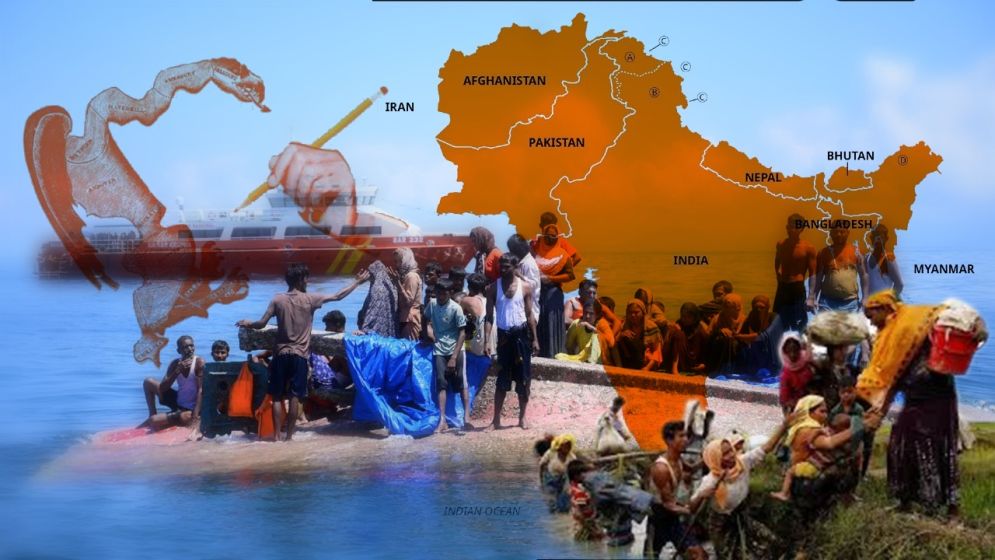Are silent push-ins at the Bangladesh border emerging as a new tool in New Delhi’s “questionable” diplomatic arsenal?

South Asia is no stranger to spectacle. Whether it's the theatrics of India-Pakistan cricket diplomacy or saber-rattling across their contested borders, the region regularly draws the world's gaze.
But a quieter, more insidious crisis is unfolding along another frontier–one largely ignored by the global press and dangerously absent from regional discourse.
Along the 4,000-kilometer plus India-Bangladesh border, a troubling practice is making a comeback: push-ins. That is, the extrajudicial and unilateral expulsion of people by Indian forces across the border into Bangladeshi territory.
It's a maneuver that flies in the face of international law, bilateral protocols, and basic human decency–and it's happening again, with disturbing scale and silence.
In recent days, India’s Border Security Force (BSF) has reportedly expelled more than 200 individuals into Bangladesh through crossings in Kurigram, Khagrachari, Moulvibazar, and Satkhira.
There’s no paperwork, no coordination, no notice. People–often dazed, vulnerable, and lacking identification–are simply dropped at the border and left to fend for themselves. Some are abandoned in remote villages.
Others, unluckier still, are pushed into the Sundarbans, a treacherous mangrove forest that swallows lives without notice.
Local Bangladeshi communities and border authorities have stepped in, offering food, shelter, and dignity where the state apparatus fails. But their involvement underscores the very problem: these are humanitarian crises manufactured by policy, not accident.
And India is not owning up to it.
Push-ins are not new. The practice drew widespread condemnation in the early 2000s during the first Bharatiya Janata Party (BJP) government, when hundreds were stranded in the no-man’s-land known as the zero line–rejected by both India and Bangladesh.
Many languished there for weeks in dire conditions until international pressure, led by Amnesty International and regional watchdogs, forced India’s Congress-led government to suspend the tactic.
It was widely seen as a shameful chapter–one not to be repeated.
Yet here we are, nearly two decades later, witnessing a revival under the current BJP government. Only this time, it’s more coordinated, less visible, and unfolding under the radar of both the media and the international community.
India defends its border policies under the rhetoric of national security and illegal immigration. But push-ins bypass due process entirely.
They strip individuals of legal recourse, violate bilateral repatriation agreements, and erode the already fragile trust between neighbors.
They turn human lives into bargaining chips in a shadow game of territorial assertion.

A dangerous resurgence
The irony is hard to ignore: even as India and Bangladesh tout growing cooperation on trade, water sharing, and connectivity, actions like these reveal the brittle foundation beneath the diplomacy.
Behind closed doors, Dhaka is watching closely. So are Bangladesh’s citizens, who may begin to question what this so-called partnership truly protects.
This is not just a border issue–it’s a moral one. And as South Asia's democracies seek global credibility, how they treat their most powerless may matter more than what they proclaim from podiums.
The push-ins may be quiet, but if left unchecked, they will not remain so for long. In Dhaka and New Delhi alike, the political costs are already beginning to stir.
The current wave of push-ins, according to multiple reports, began quietly in mid-2024–timed with eerie precision.
Just as Bangladesh entered a period of political upheaval following the collapse of the autocratic Awami League government, New Delhi appears to have seized the moment. With Dhaka distracted by internal realignment and diplomatic bandwidth at an all-time low, India moved.
On August 20, Assam’s Chief Minister Himanta Biswa Sarma publicly announced the deportation of four so-called “illegal Bangladeshis.” It was a dog whistle. More than that, it was a signal: the push-in apparatus was being rebooted.
What makes this chapter even more chilling is the scale and sophistication. In earlier iterations, push-ins largely targeted Bengali-speaking Muslims, many of whom were Indian citizens mislabeled as “Bangladeshis” based on flimsy markers like language, dress, or religion.
Today, the net has widened. It now includes stateless Rohingya refugees–people who are neither Indian nor Bangladeshi, and whom international law expressly protects from such expulsions.
In Kurigram, Bangladesh, local authorities and reporters were stunned. Out of 44 individuals recently forced across the border, 35 were Rohingyas, according to The Daily Star.
India, a signatory to numerous human rights conventions, appears to be offloading a third-country refugee population into a neighbor already burdened with over a million displaced Rohingyas.
Worse still, the logistics reveal a disturbing degree of state orchestration. Accounts from the Khagrachari border allege that some individuals were flown from Gujarat to Tripura, escorted by uniformed BSF officers, and marched through dense forest paths before being dumped at the zero line.
These are not the ad hoc actions of overzealous border guards. This smells like policy.
Anandabazar Patrika reported on April 29 that three Bengali-speaking Muslims with valid Indian ID documents were arrested as “Bangladeshis.”
Their families, desperate and disbelieving, turned to West Bengal’s citizen grievance platform Didike Bolo. But the men vanished. No hearings. No legal counsel. No answers. Just gone.
If even a fraction of these accounts are accurate, then what is happening is not merely a diplomatic slight–it is a fundamental violation of human rights and international law.
Forced deportations based on religion, ethnicity, or administrative profiling not only violate India’s constitutional protections but also contravene basic tenets of international humanitarian law, including the principle of non-refoulement and the rights of stateless persons.
At stake is the integrity of two democracies, the credibility of their international commitments, and the precedent they set for the region.

The silent consensus
Perhaps the most disquieting dimension of this unfolding crisis is the silence that surrounds it.
In the early 2000s, India’s civil society, media, and political opposition rose in unison to condemn the use of push-ins. Editorials wrestled with their legality. Activists mobilized. Lawmakers raised the alarm in Parliament.
There was, if nothing else, a clear moral consensus: this was a line a democracy should not cross.
Today, that consensus has evaporated. There are no primetime debates, no protest marches, no op-eds. Human rights groups have been muted. The opposition, disoriented or disinterested, has barely registered a response.
Whether this reflects a climate of fear, political acquiescence, or simply fatigue, the result is the same: complicity by omission. In a democracy, silence in the face of injustice isn’t passive–it’s participatory.
Meanwhile, signs suggest that India is not backing down but doubling down. On May 10, The Times of India reported night curfews and stepped-up surveillance operations along parts of Assam and Meghalaya.
For Bangladesh, this moment demands urgency and clarity. It faces a border crisis that is at once diplomatic, legal, humanitarian, and strategic. The response must be equally multidimensional.
First, Bangladesh must shore up its physical defenses–not with force, but with foresight. Investments in border surveillance technology–drones, night-vision cameras, thermal scanners–are now essential.
In hard-to-police terrain like the Chittagong Hill Tracts or the Sundarbans, coordination between Border Guard Bangladesh (BGB) units and local communities will be vital. Grassroots alert networks and community patrols can provide the first line of detection before people are abandoned in peril.
Diplomatically, Dhaka must escalate the issue beyond bilateral backchannels. The United Nations, the Organisation of Islamic Cooperation (OIC), and the South Asian Association for Regional Cooperation (SAARC) must be engaged.
India’s actions–particularly the expulsion of Rohingyas–are not merely violations of goodwill; they breach international norms, including the 1951 Refugee Convention and obligations under customary humanitarian law.
To change the narrative, Bangladesh must also shift the spotlight. For too long, it has been the subject of global scrutiny–this time, it must seize the role of whistleblower. A coordinated media campaign, backed by documentation, witness testimony, and legal evidence, can force international actors to pay attention.
Human Rights Watch, Amnesty International, and global editorial boards need more than whispers–they need dossiers.
But Bangladesh’s moral response must not be sacrificed in the scramble for sovereignty. Rejecting push-ins does not mean rejecting responsibility.
Bangladesh has shown unmatched compassion toward the Rohingya community in the past. That legacy should be safeguarded, not despite this crisis–but because of it.
At home, this crisis must be treated as a national security priority. Institutions responsible for refugee intake, social welfare, and border stability must be bolstered.
Emergency response teams, temporary shelters, and identity verification protocols should be activated in case the influx accelerates. Bangladesh must prepare not just for the present wave, but for what may follow.
Because the consequences of inaction are inevitable. Unchecked push-ins will stoke tensions in already fragile border districts. The demographic strains could trigger unrest, deepen poverty, and strain public services.
And the blurring of lines between stateless refugees and deported migrants will complicate long-term solutions—whether repatriation, resettlement, or aid.

The clock is ticking
Above all, if such tactics are normalized, they risk setting a precedent that will haunt the region.
South Asia’s geopolitical future cannot be built on a foundation of unacknowledged expulsions and strategic amnesia. If borders become zones of impunity, the idea of regional cooperation collapses.
India, as the region’s most powerful democracy, must be held to account. And Bangladesh, if it wishes to protect its sovereignty, its security, and its standing in the world, must act–not just defensively, but decisively.
This is because push-ins are no longer aberrations–they are evolving into instruments of statecraft. Whether overt or covert, these forced cross-border expulsions represent more than a breakdown in bilateral diplomacy.
They are calculated moves that defy international law, trample human rights, and test the limits of regional tolerance.
For too long, Bangladesh has met these provocations with studied restraint–guided perhaps by pragmatism, perhaps by hope that diplomacy alone would suffice. But hope is not a strategy. And silence, in the face of repeated violations, is not diplomacy—it’s acquiescence.
If Bangladesh continues to meet unilateralism with deference, it risks more than embarrassment–it risks the erosion of its sovereignty and the normalization of being treated as a geopolitical dumping ground.
The time has come for Dhaka to shed caution and step into conviction. That means recalibrating its diplomatic posture, building coalitions with regional and global partners, and asserting its case through international legal frameworks–not later, but now.
South Asia’s silence today could become tomorrow’s precedent. If push-ins go unchallenged, they may soon become policy–not just in India, but across a region already strained by migration, statelessness, and communal volatility.
Bangladesh cannot afford to let “what happens next” be determined unilaterally by its neighbors.
As the Indian comic Bhanu Banerjee once quipped, “Let’s see what happens” might work in cinema. In geopolitics, it invites disaster.
Bangladesh must act–not through escalation, but through enlightened, assertive diplomacy. It must speak clearly in international forums, demand accountability from its partners, and show the world that small states, too, can wield power through principle.
The world may be watching in silence–but Dhaka must not mirror that silence. It must answer injustice with strategic resolve. Because in border politics–as in life–silence rarely stands on neutral ground. More often than not, it stands with the aggressor.
The time for quiet diplomacy is over. The time for a calibrated, courageous response is now.
—-
Tanjina Aman Tanjum is a fellow at Institute for Environment and Development

